Έκθεση παραδοσιακής φορεσιάς
14 Σεπτεμβρίου 2018 - 30 Οκτωβρίου 2018
|
Έκθεση παραδοσιακής φορεσιάς με τίτλο "Όμοια και ανόμοια της παραδοσιακής φορεσιάς Ρουμανίας- Κύπρου"
Αποτελέσματα ερευνητικού προγράμματος μεταξύ πολιτιστικού λαογραφικού ομίλου Λευκωσίας και του χορευτικού συγκροτήματος Muresul από Turku Muress, Ρουμανιας
Με τη συνεργασία του δήμου Λάρνακας και της Κυπριακής χειροτεχνίας Κύπρου.
|
|
|
|
| |
Photos  Click on images to enlarge Click on images to enlarge |
|
| |
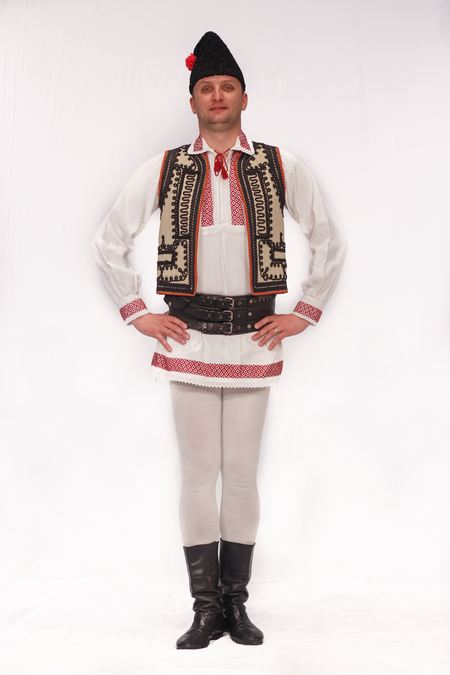
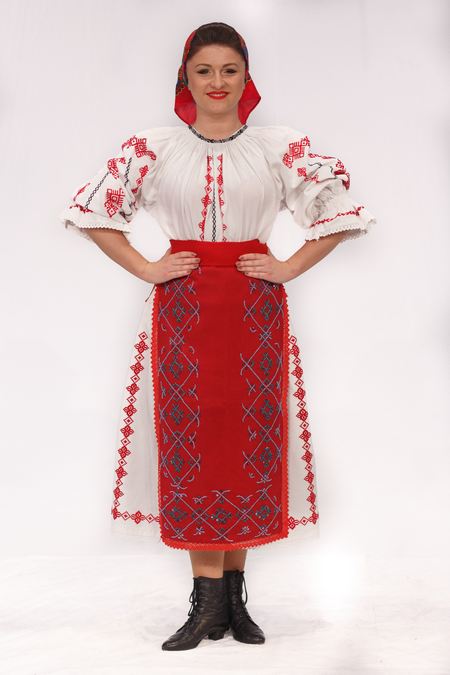
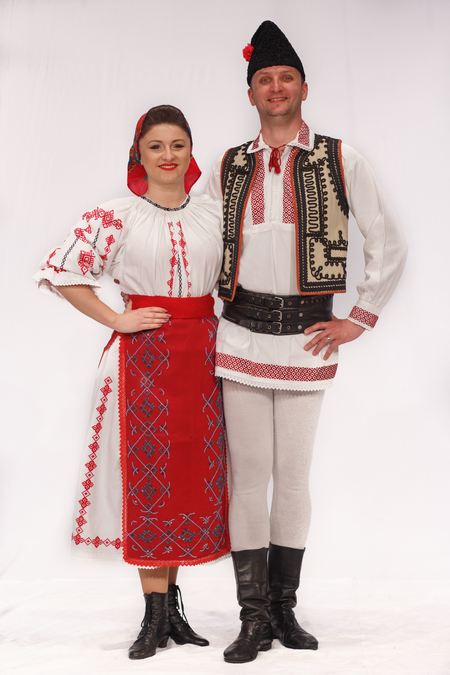
Folk costume from Banat
The elements differentiating the traditional costume from Banat within the Romanian folk clothing are related, on one hand, by the existence of certain unique features, which can only be found in this historic province - the long fringes apron "catrință" and the chignon "boneta" worn by women -, and, on the other hand, the sumptuous character of the embroideries and the colourful motifs handcrafted with gold and silver wire. The men’s costume, consisting of a knee-long shirt, matched with cloth trousers in summer and thick trousers "cioareci" made of white wool cloth "habă" in winter, has as distinctive sign the very refined crochet lace – ton sur ton (with thread or white silk) - and the finesse of the small decorative keys joining the cloth sheets. The waistcoats and winter coats, highly decorated with polychromatic silk embroideries, with mirrors, buttons and leather inserts, make the Banat outfits very admired. Remarkable for the beauty of the handcrafted décor, with black string "șinoare" inserts on the white background of the wool fabric, are men’s bests "chintuș" and the long fur coats "șube" worn by both genders. The woman of Banat states her social and economic status through the richness of the jewellery made of gold and silver coins, joined through ingenious settings, executed by local craftsmen or jewellers from county seats. In Banat, there is an incredible diversity of necklaces "salbe" and neck plates "table", belts "brâuri", aprons "oprege"/coin patches, shirts "comăși" or "gălane", veils "tulbente" or horse tack "căpițe" and the other decorative items for horses’ heads "pleceniși" and "fruntari", but also silver needles with filigree handcrafted ends for cloths "cârpe"/headscarves and for holding braided hair.
|
| |

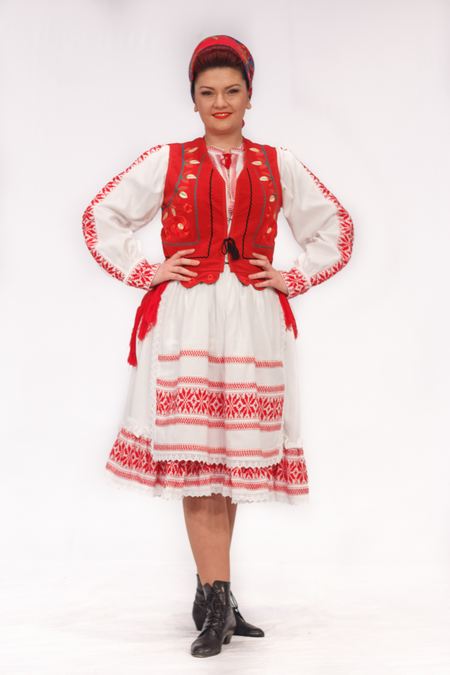
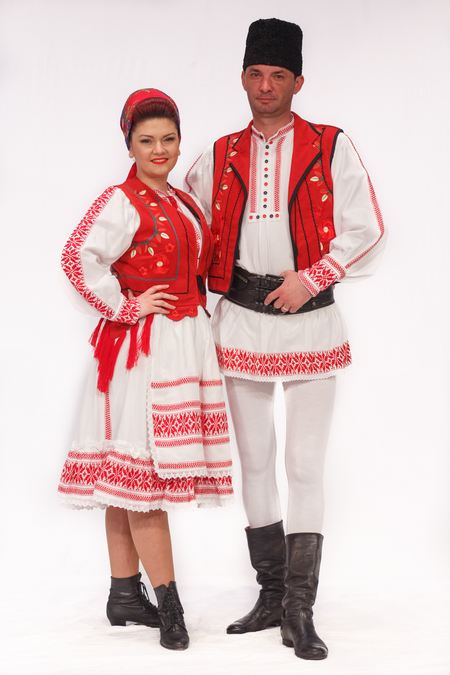
Folk costume from Bihor
The women’s costume consists of the head garment, shirt (underskirt), apron, belt and footwear. The hair was braided and rolled around two chignons called "cormi", placed above the ears, the head was covered with a white cloth decorated with colourful motifs "alesături", and bead strings were worn around the neck. They wore a long shirt sewn along the sleeves and with long coloured bracelets "pumnari" embroidered on the edge of the folds, black apron made of wool, and on the front, belt woven from colored wool. On top of the shirt, they wore a sleeveless coat "cojoc", a little longer than the waistline, and on their feet, they wore wool or hemp foot wraps "obiele" or peasant sandals "opinci". On holidays, they added the hand-made cloth "ștergar", heavily decorated with colorful motifs "alesături" and instead of the peasant sandals, most women wore black boots. The folk clothing of Bihor is part of the costume typology from the Western side of the country, where the line, as the components of the costume, show some deviations from the authentic type of Romanian clothing, through the fixed curving of the underskirts and the absence of the straight apron from the back and the short shirt, worn without a belt, and the baggy trousers "izmene" for men.
|
| |
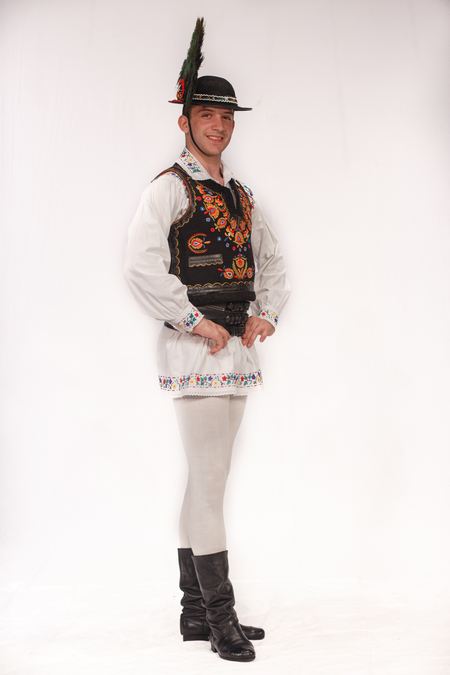
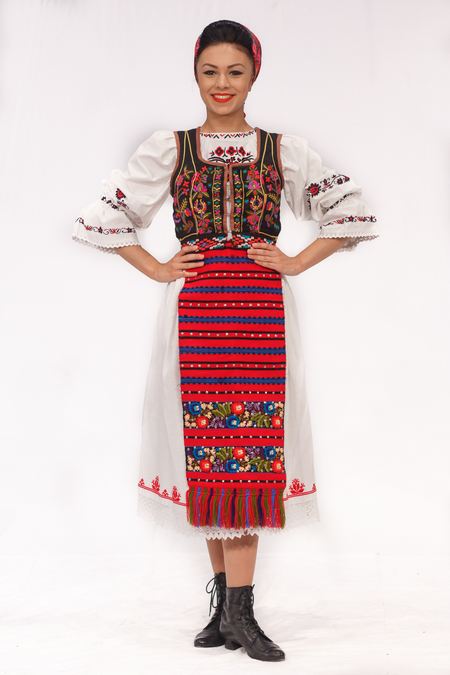
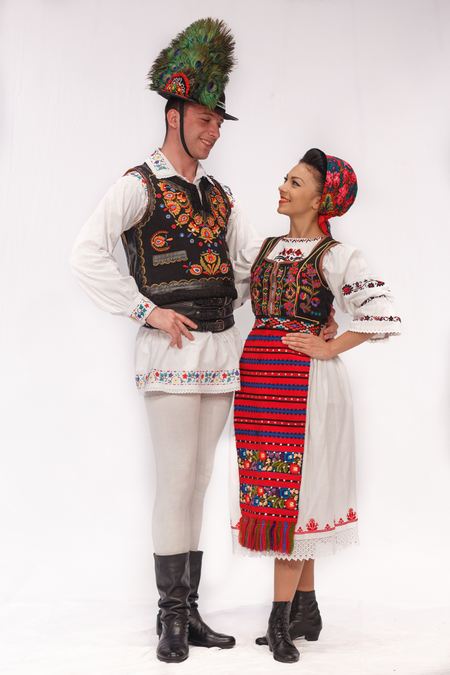
Folk costume from Bistrița
The women’s folk costume consists of a square scarf “năframă”, shirt “cămașă”, underskirt
“poale”, apron “zadii” or “șurț” and waistcoat “pieptar” and a coat called suman (worn in the
winter). Two circles made of ostrich or peacock feathers, placed next to the ears, sewn in the
middle with colored beads, called “păunițe”, are specific to unmarried women in the Sângeorz
area. These “păunițe” were attached to the head with a headband, decorated with beads. A
distinctive sign of the men’s folk clothing in the Năsăud (Someș River valley) is the peacock
feather hat, worn by unmarried young men. The traditional men’s costume consists of a knee-
long white shirt made of cotton or hemp, white trousers made of linen, hemp or wool during the
winter, and, as footwear, boots and peasant sandals “opinci”. On the head, men wear a hair hat
“clop de păr” during the summer, and a lamb fur hat during the winter. In the Năsăud area,
young men wear hats with peacock feathers placed radially, decorated with bead strings. Young
women wear predominantly red costumes, consisting of ankle-long white underskirts, on top of
the underskirts, the aprons are attached with a belt “brâu”, white shirt heavily decorated with colored beads and flower motifs, lamb skin waistcoats “pieptar” and peasant sandals “opinci”; in winter or shoes in summer.
|
| |
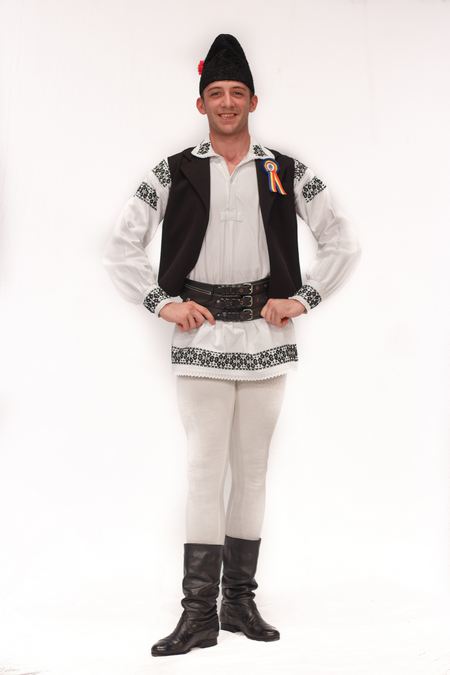
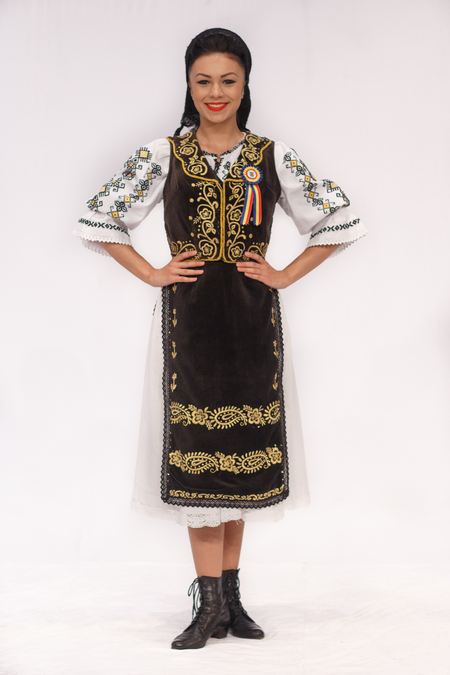

Folk costume from the Transylvanian Plain (Câmpia Transilvaniei)
The Transylvanian Plain is the large area in Transylvania located between the Mures River Couloir (in the South) and the Someșul Mare River Valley (in the North), and bordered all around by an entire chain of smaller and larger towns, such as: Cluj-Napoca, Dej, Bistrița, Reghin, Tg.-Mureș, Turda. The men’s folk clothing consists of the following parts: shirt, tights "izmene", tight winter trousers "cioareci", broad belt, waistcoat "cheptar", short sleeveless coat "laibar", long coat "suman", winter coat "cojoc", boots "cizma", hat "clop". Besides from the shirt, the women’s folk clothing also includes a skirt made of curly or folded wool fabric "fota", an apron "șorț", the underskirt "poale", the headscarf "ștergar de cap", the small hat "pălărioară", the chignon "conci". For women, straight aprons were worn in pairs. The predominant colors in the Someș River area are white and black. The top part, also called the body "trup", was monochromatic, dark purple for old parts and black for recent aprons. The men’s folk clothing consists of the following parts: shirt, tie, tights "izmene", thick socks "solovari", tight winter trousers "cioareci", broad belt, waistcoat "cheptar", short sleeveless coat "laibar", long coat "suman", winter coat "cojoc", long fur coat "bonda", hood, peasant sandal "opinca", boot, summer hat "sapca", hat "clop". One of the most important feature of the folk clothing from the Transylvanian Plain is simplicity. Old shirts were tailored without a collar, only with a stripe with sewn ornaments and puffy sleeves. Shepherds in particular have kept to this day the puffy sleeve shirts, because while milking the sheep, it’s easier to roll up their sleeves, and the shirts and the underskirts were made of lawn, matched with waistcoat "pieptar" and thick cloth straight aprons "cătrințe".
|
| |
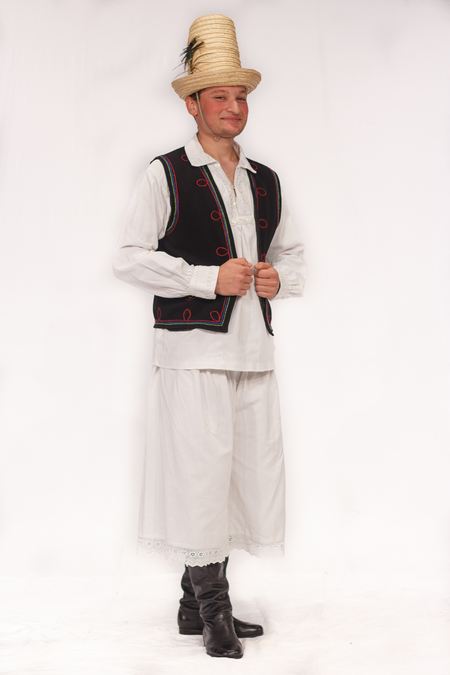
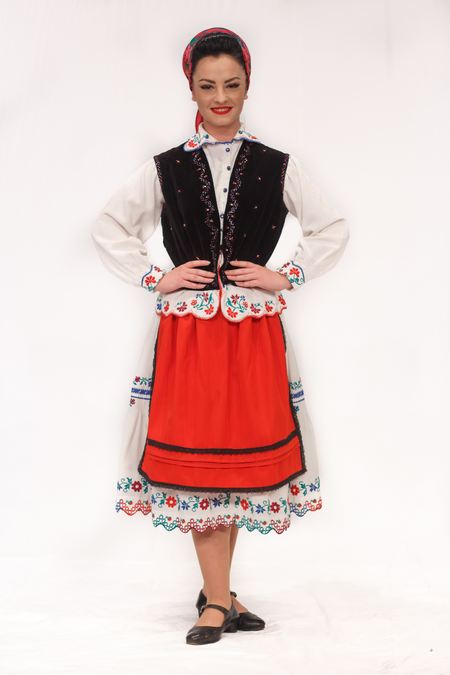

Folk costume from Chioar-Maramureș
The traditional clothing of Chioar has specific elements connecting with the adjacent areas, but also with the more remote ethnographic areas (Vâlcea, Bucovina), which proves the unity of the Romanian folk clothing. The men’s costume consists of the baggy pants "gaci/cioareci" made of a white thick fabric called pănură, worn during winter, cloth shirt, short black sleeveless coat "laibar" made of cloth "postav" or thick fabric "pănură". The rather tall wide brim straw hat stands out. For women, the costume varies according to age. Girls wear beautifully embroidered shirts, handcrafted by sieve, with brightly colored flowered underskirts "poale", black wool aprons "zadii", decorated with vertical stripes, colored in black, red, green or grey, and during winter, they wear a knee-long wool coat "gubă". Here, the women’s costume is made-up of the head garment, dress, underskirt, apron and shirt, called spacel. The difference compared to the shirts used in other areas of Romania is that it has a rectangular neckline. Moreover, the sleeves are crinkled and decorated with laced embroideries. The sleeves are tied with a ribbon at the base, in order to create an effect that is specific to the Maramures area. The black band with red flowers inserted at the base of the neck and the sleeves complete the shirt’s traditional look.
|
| |
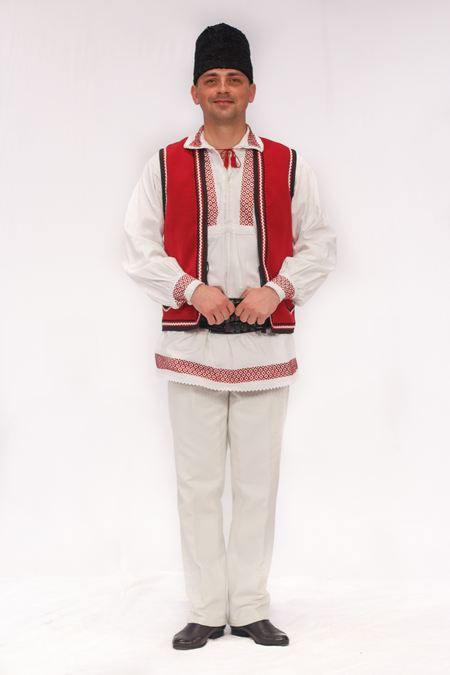

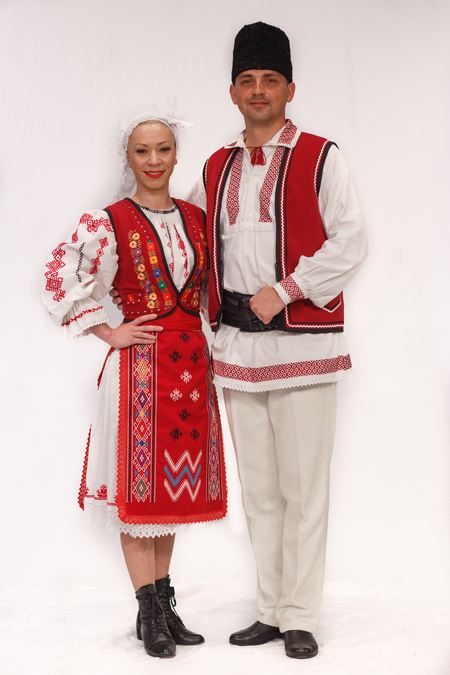
Folk costume from Dobrogea
The Dobrogea clothing shows the features of both mountain and plain areas, from the left bank of the Danube. The Dobrogea folk costume, consisting of shirt "ie" made of white cotton lawn, manually sewn with white silk thread, underskirts made of lawn, with white lace inserts, a skirt made of curly or folded fabric "valnic" or "fota" around the waist, loom woven, white, with golden lurex, woven red belt and headscarf "marama" made of lawn, sewn with white silk. Compared to women’s clothing, men’s clothing is less decorate, from both the perspective of motifs and motif layout. Round, pointy hats, with circles, are made of lamb fur. The shirt, initially a "large shirt" "camasoi", straight, without yoke, open in front, with puffy sleeves, was replaced, in the beginning of the 19th century, by a shirt with yoke, straight collar, with lining "banta" in front and sleeve “bracelets". The shirt is decorated with a collar pattern, with “bracelets" or cuffs and separate decorative elements "pui" on the chest. Men’s shirts stand out through the use of gossamer in tailoring celebration shirts. Simple trousers, made of dark cloth, were decorated with colored silk ropes "gaitane", tied at the waste with a red or white broad belt.
|
| |

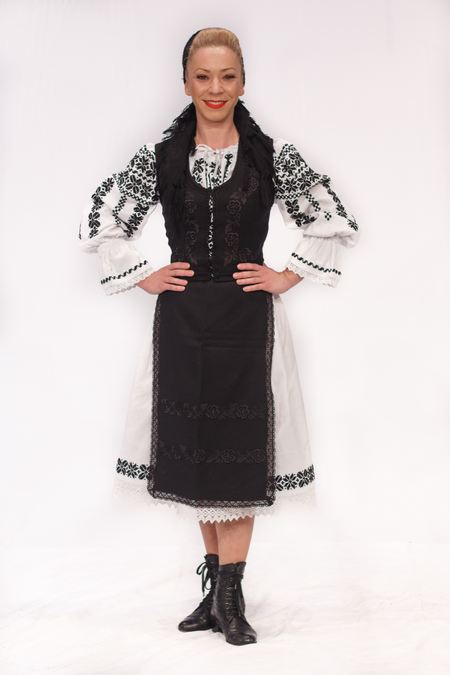
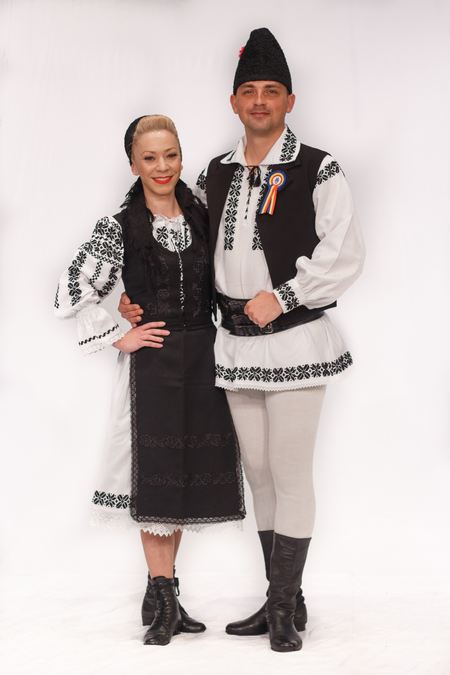
Folk costume from Haidău-Alba
The specific items of the men’s clothing were the lamb leather hat in winter, and the straw hat in summer. Narrow brim black felt hats appeared later on, also under the influence of the Mărgineni clothing. By the end of the 19th century, the traditional shirt "ie" with the underskirt "poale" were made of hemp or linen, being woven with red and blue stripes, with a very simple tailoring. Over the underskirts, in front, wool aprons "șurțe" were worn, dyed in various colors. On the edges, a crochet handcrafted lace was sewn, and on the bottom side, it had pompons. In the back, they wore straight aprons "cătrințe", simply sewn, made of black wool. The headscarves "proboade" worn after World War I were replaced by a black, white or colored square scarf "chișchinaua", but continued to be worn by old women in church and to funerals. On top of the traditional shirt "ie", women wore waistcoats "pieptare" split in front and embroidered with dyed cotton thread. On top, they wore white winter coats "cojoace", also decorated, particularly for young women. In time, this waistcoat "pieptar" was made of soft cloth or velvet. The cincture called "brăcie" (belt) was made of red or three-color wool, 10 cm wide. The main parts of the men’s costume are: white shirt initially woven from linen and hemp, and later on, from cotton. The shirt cloth has red or blue stripes, with a palm’s width distance between them. The shirts were long, and the old ones did not have embroideries. On top of the shirt, men wore a broad belt "șerpar", made of black or brown leather; the old ones were handcrafted with embossed geometric motifs. Men’s clothing included white thick trousers "cioareci", with or without pockets and the tailoring (seam) on the sides. In late autumn, winter and early spring, a knee-long coat "țundra" made of a white thick fabric called pănură was worn, supported by a string "baieră", braided and tied next to the neck, so that the hands could remain free, to carry the bag "traista" and the stick. The typical clothing item of older people was the long black fur coat "șuba" with patches "clini", made of black pănură, reaching below the knees.
|
| |


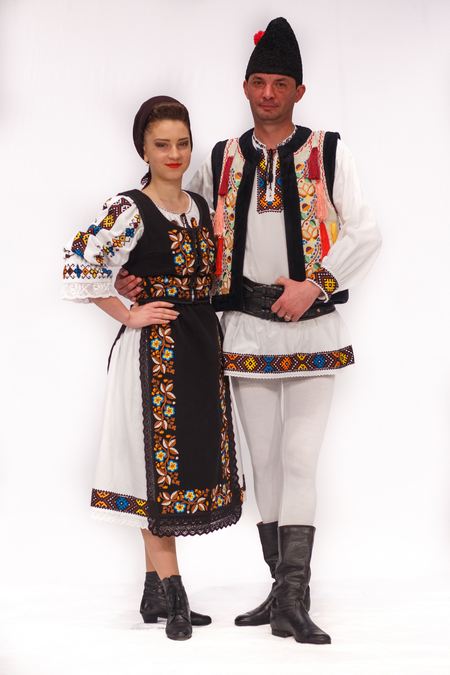
Folk costume from Idicel Mureș
The village is located at the bottom of Gurghiului Mountains, in a picturesque foothill area. The folk costume of Idicel habitants consists of tight winter trousers "cioareci" made of a white thick fabric called "pănură", white cloth, almost knee-long, lamb fur waistcoat, coat "suman" made of black thick fabric "pănură" or winter coat "cojoc", during the winter, and during the summer, they gave up the winter coat and replaced the winter trousers with tight trousers "ițari", made from a combination of wool and hemp. On the waistline, they wore a wide leather belt "șerpar", and on the head, black lamb fur hat or wide brim hat. The footwear was in most cases the peasant sandals "opinci", and the richest wore boots and brogans – these made-up the men’s clothing. The women’s clothing consisted of cloth underskirts, straight aprons woven from wool or cloth made of the same fabric, attached at the waistline with a woven belt "lorineață", white cloth shirt with sewn or woven strings, lamb fur waistcoat with decorative leather edge "zăgărea", coat "suman" made of a thick fabric "pănură" or winter coat "cojoc". On their head, they wore thick wool scarves, woven or knit, and the younger women wore a "ceaptă", which was similar to a veil with a collar made of small silver coins, and on their feet, peasant sandals or long boots.
|
| |
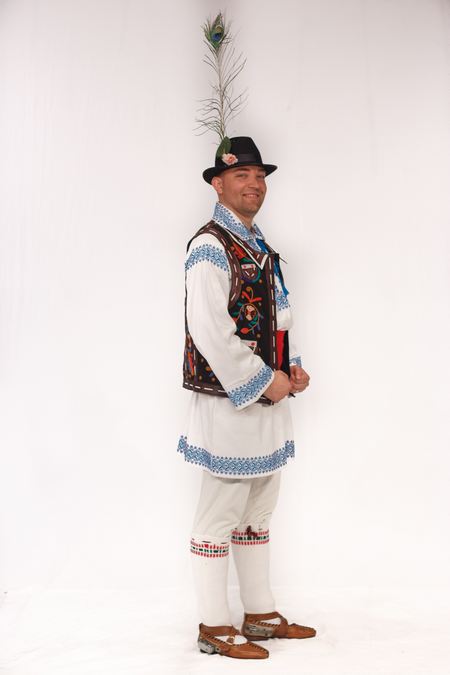
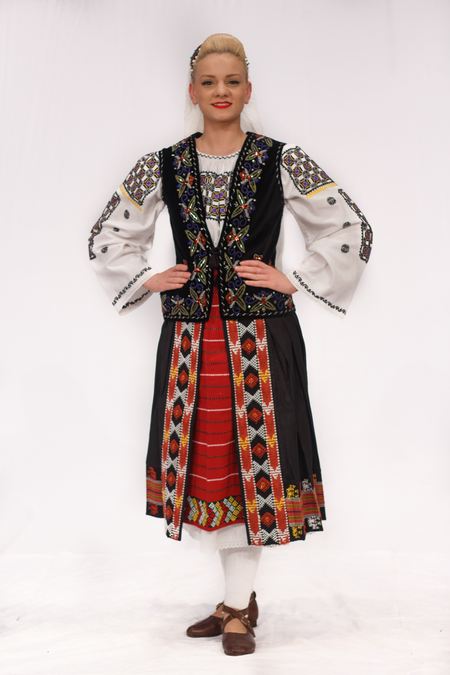
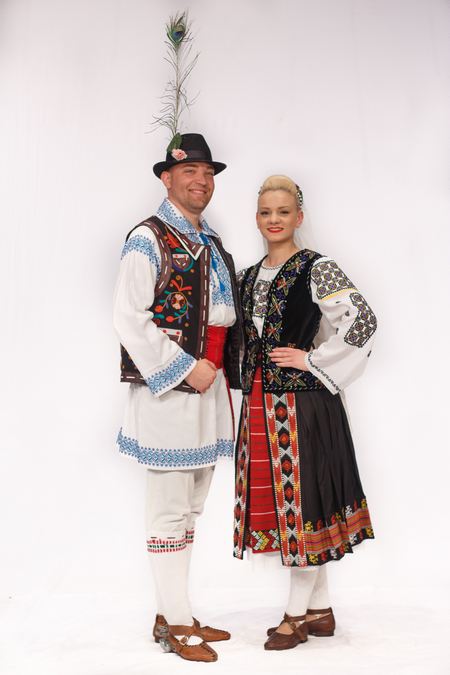
Folk costume from Vlașca Teleorman
Traditional Romanian clothing is the clothing worn by Romanians both during working days and celebrations. The women’s costume is made-up of a straight shirt or a casual shirt for working days, the traditional shirt "ia" or the shirt crinkled at the neck, straight aprons "catrințe", wrapped round skirts "fote", split skirts "vâlnice", broad belts "brâie", while the men’s costume is made-up of shirt, thick trousers "cioareci", tights "ițari". Footwear, headscarves "marame", cloths "ștergare", wool stockings, foot wraps "obiele" and jewellery are also a part of the traditional Romanian costume. The raw materials used to make the traditional costume were wool, hemp, linen, cotton and gossamer. Men’s and women’s shirts were made of hemp, linen or cotton, woven with two threads, while the wrapped round skirts "fote", split skirts "vâlnice" or aprons "pestemane", in Vlașca, where warmer colors are used, several shades of red, golden, ochre for men’s shirts and traditional women’s shirts "ie".
The Vlașca – Teleorman area: The women’s costume (the decorating style shows small local variations): the shirt on the same configuration, however, the spiral motif appears
on the sleeve; the skirt, consisting of three quarters black split skirt "vâlnic" and a straight apron "catrință" – red apron "pesteman" or folded wrapped round skirt "fotă"; linen headscarf "maramă" with broken geometric ornaments or attached to the hair with handcrafted hairclips, peasant sandals "opinci". The men’s costume: white shirt; white cloth tights; broad red wool belt "brâu"; wool socks; peasant sandals "opinci".
|
| |
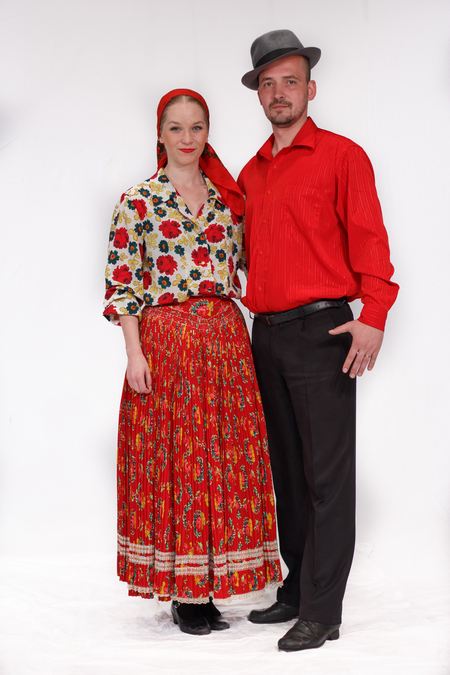
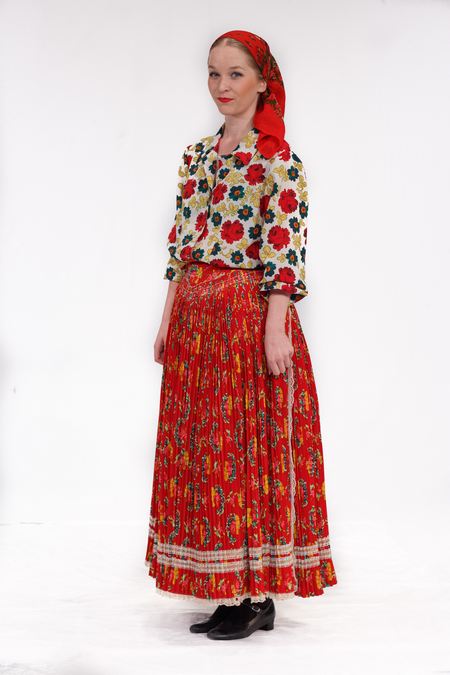

The gipsy costume
The gábor gipsies are gipsies who are living in Romania (especially in Transylvania). A very special feature is the black hat with a large brim, respectively they enormous moustache, as well as the women’s multicoloured folk costume. They consider that their costume is ancestral. Along with the men’s traditional costume, besides the black hat with a large brim, belong the large black pants and the black jacket (under which they would wear a shirt). The elders would often wearing a vest with silver buttons and which was inherited from father to son, and sometimes a silver pocket watch. Most frequently they were wearing closed patent leather shoes. The women’s costume is composed of a coloured pleated skirt, a decorated blouse and a pleated apron with the same motifs as the skirt. The women also wear a scarf. The little girls braid in their long hair, which reaches the ground, a red ribbon. They wear until the age of 9-10 a totally different costume compared to the adult women, but from this age they are expected to wear a grown up costume. The basic colour of the skirt until the age of 24-25 is light (white, beige, red), between the age of 25-60 they can wear green and purple coloured skirts. The blue and brown skirts are worn by old women.
|
| |
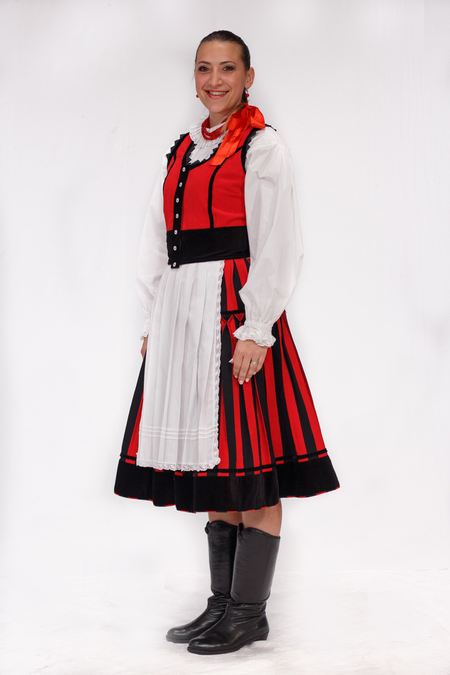
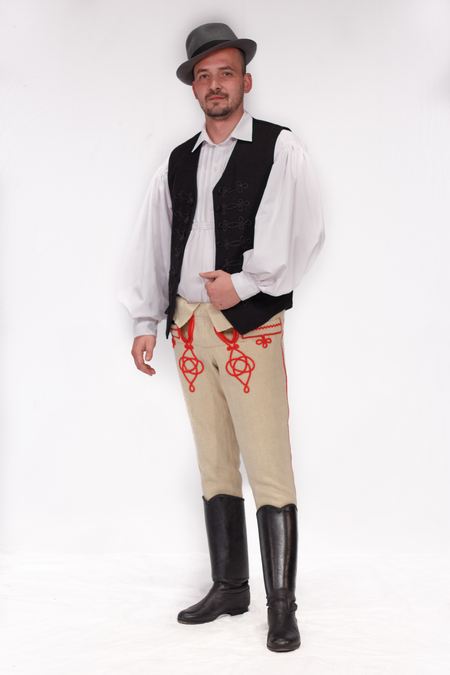
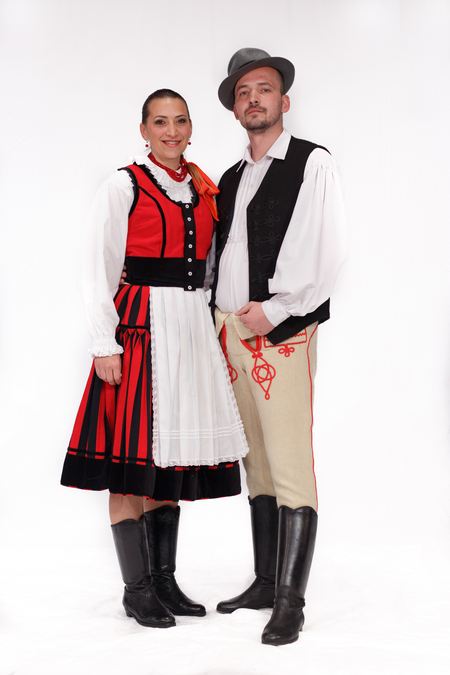
The folk costume from the region of Felcsík
The men’s notorious piece of the Sekler traditional costume are the white broadcloth pants, formfitting on the legs – called “harisnya” (stalking), the string decorations of which could vary from one area to another or from one village to another. With pants it is appropriate to wear black boots with a string decorated frame and with a tough upper side and a white cloth shirt with a closed collar and with simple sleeves. In a few places, over the shirt was worn a decorated vest with red and blue strips, decorations called “sujtás”. During summer, they would usually wear the black hat – along the Küküllő river during the week the straw hat – and during winter the lamb fur hat with a blunt cap or with the bottom side folded in the exterior. Over the vest they would wear the short broadcloth overcoat, grey or black, the long jacket being also very rarely seen at the elders. Nowadays, event the men who are fond of traditions are wearing with the traditional pants and black boots only the jacket or the short overcoat. The main piece of the female folk costume is the upper coat formed of two parts, the dress and the vest. The dress, at the waist, is folded, and in the bottom side it has a narrower or broader velvet model. The dress from Csík is made of homemade fabric with coloured stripes, the width of the stripes, respectively, their chromatics varying depending on the age category or the occasion. The short and slender vest could be also made of the striped material of the dress or from cloth made in factories, with a single colour, decorated with strings or beads. The bell shaped dress was usually matched with a silk apron, with narrower stripes or with a single colour, respectively, with fabric double. The aprons are embroidered with floral motifs. In Csík, boots are worn traditionally. The girls do not wear a scarf, usually pinning their hair into two braids, with a ribbon in both of them. The simple necklace, made of beads placed on strings, has two long ribbons which are hanging in the back. The younger and older women usually pin their hair in a bun with a scarf, the colour and embroidery of which is different depending\g on the age and occasion.
|
| |
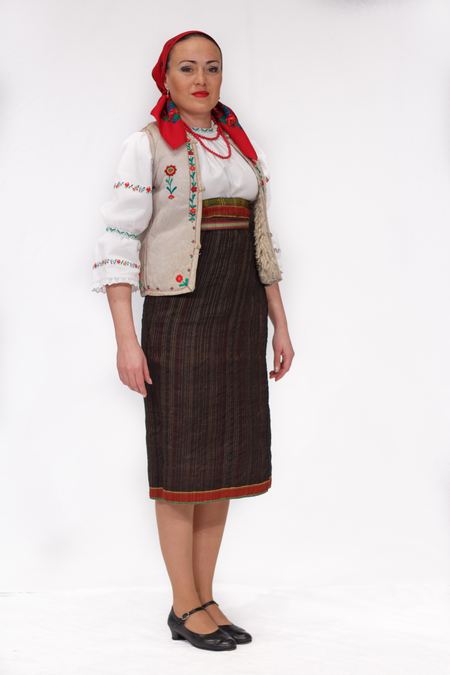
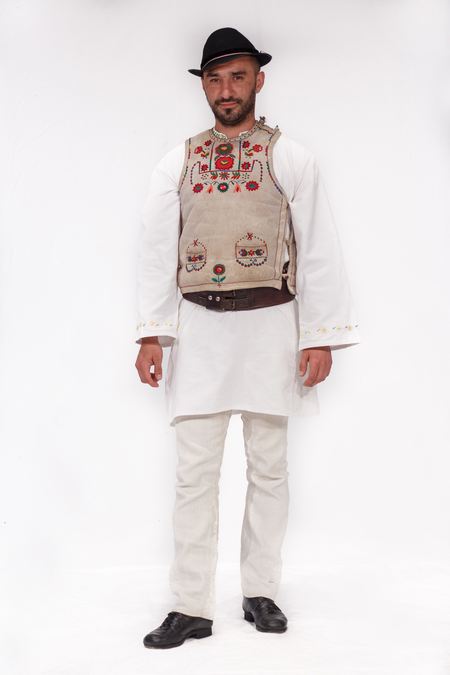
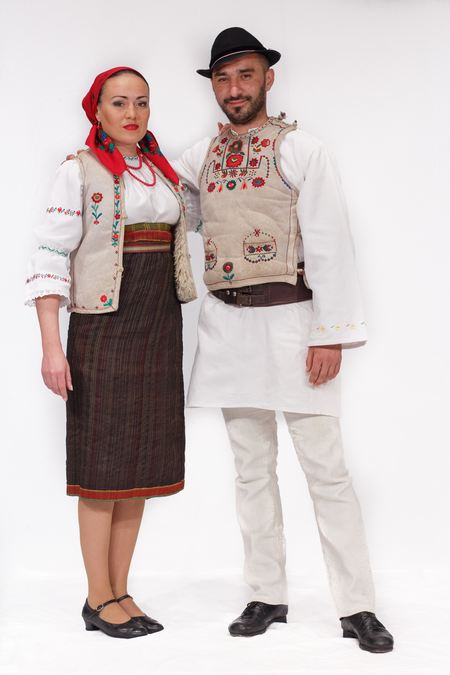
The folk costume of the Csángó’s from Gyimes
Their folk costume is unchanged since the 1920’s and until the present. The clothing of the ceangăi was manufactured almost integrally on a local plan, handmade, only the scarves and beads were bought from merchants. The skirt – veil (katrinca) from the women’s costume is the most ancient form of skirt. Their shirts embroidered at the shoulders were decorated a long time ago with geometrical motifs within which was found the most loved form of embroidery, with the seam backwards. Today, this extremely difficult type of embroidery was replaced by the floral motifs achieved in the technique of the embroidery in transversal points (“keresztszemes”). A long time ago, the shirt was united with the bottom skirt, as it also shows the name of ”the bottom of the shirt”. Today, we are already talking about a separate piece which in the bottom side has a lace decoration. Over the shirt and over the bottom of the shirt, equally at the waist, was wrapped a broad belt made of wool over which is dressed the “katrinca” which is fixed under the breast with a woven tight coloured belt (the so called “bernyóc”). The girls and women were wearing necklaces made of beads with several strings. The wearing of the scarf is general, being worn by everybody, from girls to old women.
The most adorned piece of clothing of the women’s costume is the leather vest with coloured embroidery (“lajbi bunda”). The old women are wearing the so called “hámos ujjast” (jacket with harness) of a red-speckled colour, this piece of clothing being composed only of sleeves which at the shoulder blades are tied by a “harness”. During winter they were wearing a broadcloth jacket – “zeke” identical with the one of the men. The male folk costume from Gyimes is very similar to the farmers’ costume from the medieval representations. Their long shirts let loose are related to the tunics from the Roman period. As well as the slacks formfitting on the legs.
|
| |
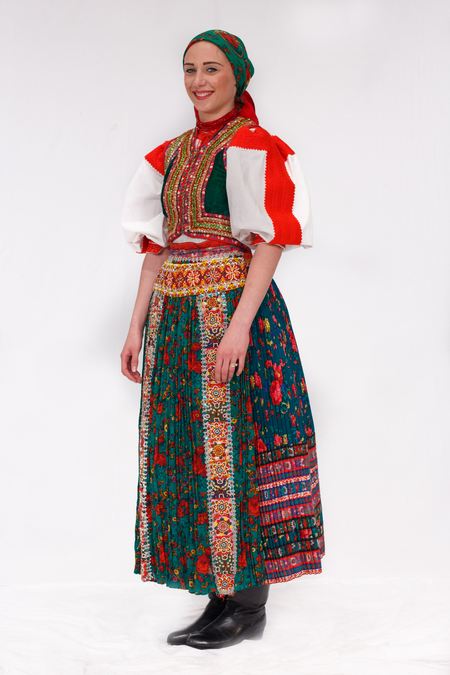
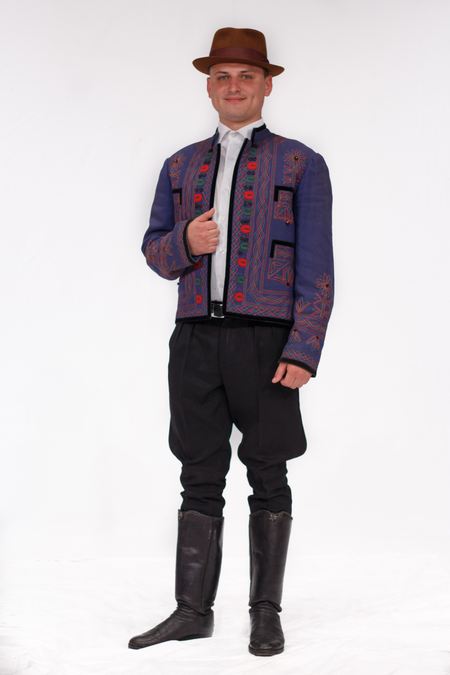
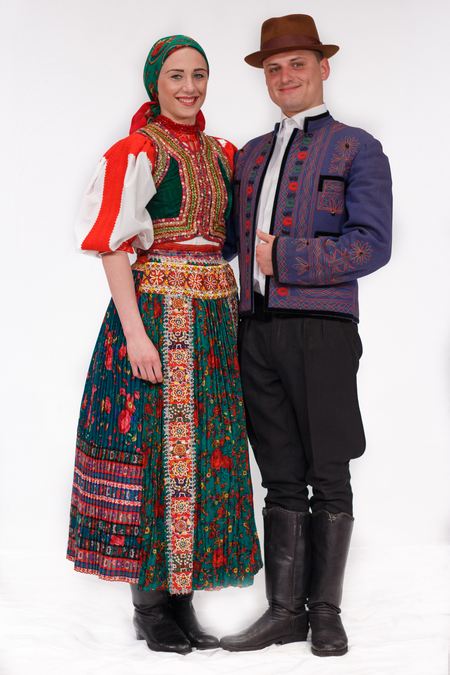
The folk costume from Ţara Călatei
Due to the special abundance in colours and decorative motifs, the folk costume from Kalotaszeg is one of the most known Hungarian traditional costumes. Especially the hairdo and the accessories for covering the head of little girls, grown up girls and women, were defining. The little girls were wearing “egytyikás” hairdos with two braids, grown up girls with one braid, most of the times with a red ribbon. “Párta” – the tiara with veil, is a masterpiece of the Hungarian folk art and which the girls were wearing from confirmation until their wedding. The most usual accessory for covering the head is the daily scarf or the one for celebrations. The front part and the back part, respectively the sleeves of the broad shirts were adorned with wrinkles, being tied at the neck, in the collar and on the sleeves in the cuff. The decorative motifs could vary in colours depending on the locality, bearer, age (red, blue, black). The long shirt, the so called “pendely”, which today would correspond to the slip, was manufactured of homemade hempseed cloth. Over the “pendely” was coming the “muszuly” or “muszuj”, a piece of clothing characteristic to the folk costume from Kalotaszeg. The two bottom corners were introduced in the belt from the waist, the inner liner made of broadcloth being at sight and giving a clue concerning the bearer’s age and financial status. One the most beautiful article of clothing of the body’s superior part is the laced breastplate or with beads (pruszli or lájbi). The outfit was completed by the wool handkerchief opened in two and carried on the arm. The women from Kalotaszeg were wearing boots with soft upper sides, with wrinkled upper sides (kukuj) or hard upper sides and the top of the boot rounded. Along the history, the men from Kalotaszeg have worn different types of hats. During winter they would wear a furry hat, while during summer they would wear the straw hat. The men were wearing shirts with broad sleeves, with incisions, white embroidery and decorations with tassels. Later came along the fashion of the trousers “priccses”, for boots, made of fabric, or of the pants, all of them more suitable for the city. The men were wearing boots with hard upper sides or formfitting on the legs, which beginning with the First World War left place for the boots.
|
| |

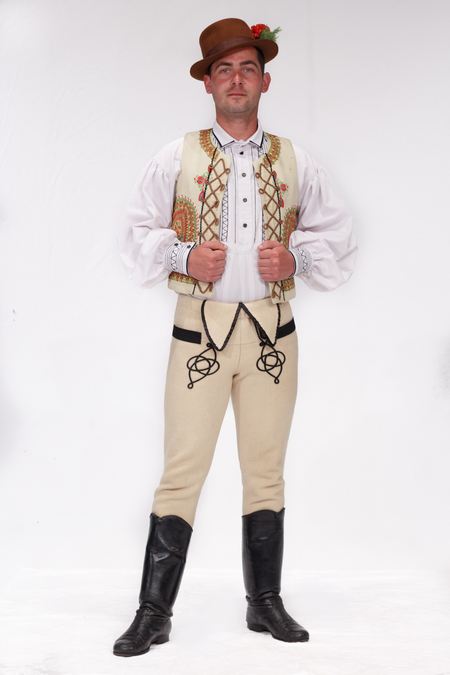
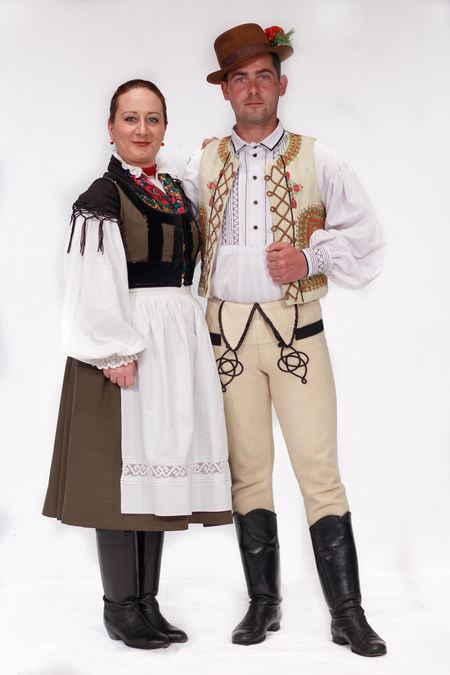
The folk costume from Küküllő-mente
The girls would wear at the neck a collar made of glass beads, with 2-3 rows, which initially was
worn tight on the neck and then hanging. “Lékri” or the blouse used to belong to the ancient pieces of clothing, around the end of the XX th century. Their material was bought from the Medgyes fair: fabric, glossy silk, of one colour or with motifs. There is a darker version, but also a lighter one, with a row of buttons in the front. The waist was modelled, the sewn sleeve was pleated on the shoulders, it narrowed towards the forearm, and from the waist down it extended with or without folds. The festive attire was always black or dark blue. The breastplate was made of the fersing’s material or of the blouse and the shirt could be seen under the breastplate, over the fersing and the blouse. This had to be matched in material and colour with the fersing. The velvet fersing was matched with a velvet vest, depending of the age, red, green or black. It was decorated with a string under the form of a clover or roses, and also the vest with beads, where the black beads were sewn next to the string. The lads would place in their green hats stipa bouquets. The elders were wearing black hats, without bouquets, while during winter they would wear black fur hats. The men’s shirt was with a sewn, large sleeve, pleated at the shoulders and at the wrists it was closed with a three-fingered broad cuff. On the shirt’s chest, on one side and the other of the opening, were applied 6 “zájmeli” – folds pinned through a sewing machine seam, the shirts sewn handmade, from the beginning of the XX th century also being decorated with laces. The pants – “gagya” – were made of a mixed material, the cotton being mixed with hempseed, working with two shuttles, one having a cotton thread, the other a hempseed thread. Neither in this region the breastplate was coloured, being sewn from wool of a single colour – grey.
|
| |
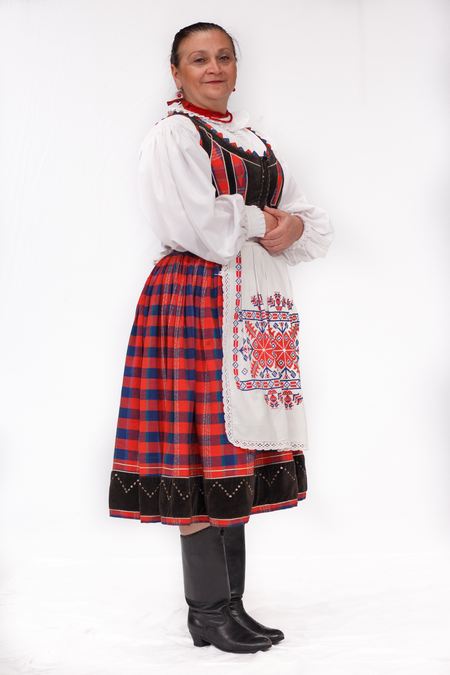
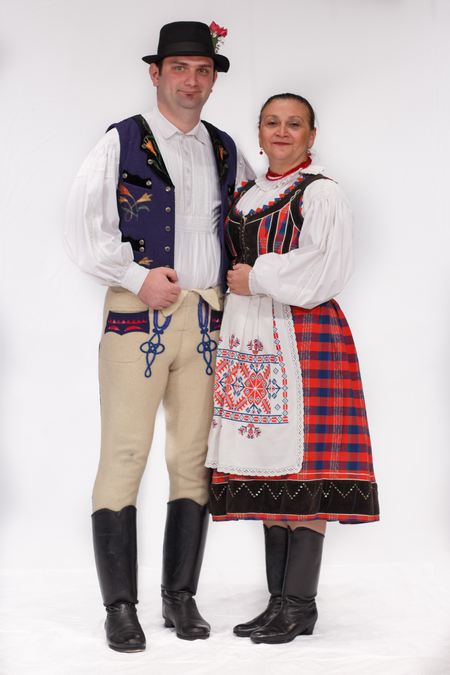

The folk costume from Marosmagyaró
The tradition from Marosmagyó still says that a long time ago the elders could dress completely from the hempseed that they were cultivating, from the wool and the sheep’s skin, the pig’s and cattle that they were raising. At men was characteristic the woven shirt with a long sleeve, without collar, cut in front and which was tied with a string, kept outside the pants, pinned with a broad belt. They were wearing slacks with lint. The elders in the 1920’s were still wearing a round haircut with bangs (körhaj) over which they would wear a hat with a broad brim and a straight cap (“kürtőkalap”). During winter, over the large shirt taken out from the pants, they would tie the so called “bőrdeszü” which during the summer they would wear under the shirt. Over this they were wearing a cloth “gujbi”. And the traditional white broadcloth pants without decorations were handmade. The women were braiding their long hair into two dreadlocks with a ribbon. The coloured scarf went into fashion around the XIXth century. The white cloth robes represented the women’s and men’s lingerie. The girls, until their teenage years of confirmation, would wear a long shirt, receiving a short shirt or a “pendely” only in the period between the wars. The women’s skirt is special because it has a design with plaid, blue or red, the same as the apron.
|
| |
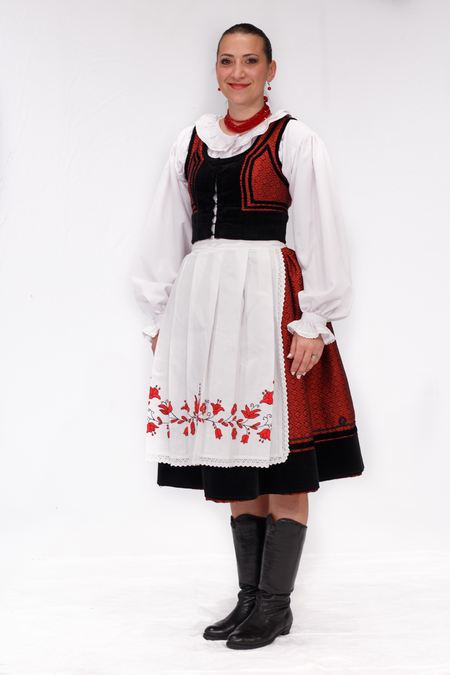

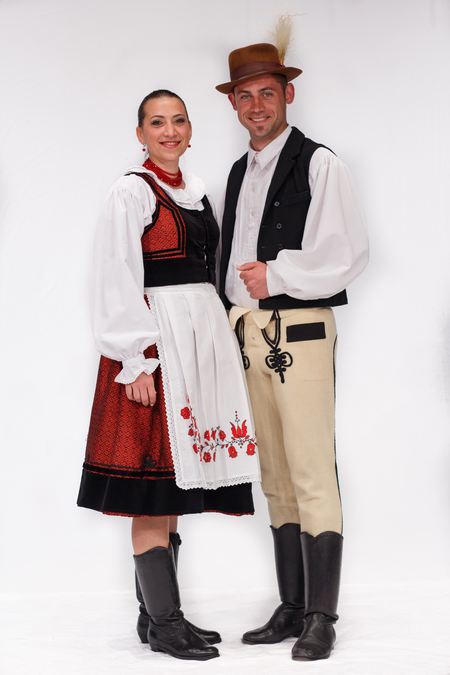
The folk costume from Mezőmadaras
For the period before the First World War, the women’s characteristic festive clothes consisted of a long skirt which reached the ankles, a scarf, and at men the Sekler pants. The skirt has become shorter after 1920, reaching the middle of the shin, while the young men have begun to wear the “priccsesnadrág”. This change can also be observed in each locality from Nyárád river are, but besides the specific notes, the folk costume has had the features characteristic for each village. All over the place, the women were wearing embroidered dresses. Besides the pieces of clothing from the markets, the fabrics made of hempseed and the wool clothes have persisted until the middle of the XXth century. A special curiosity is the fact that the folk costume of the women from upper part of the Nyárád river was alive until the 1940’s-50’s, while on the lower part of The Nyárád river only until the 1930’s. On lower part have appeared the porcelain pants (a piece of clothing which was similar to the traditional Sekler pants, made of white cotton fabric), porcelain dresses, at the same time with the hempseed dress, which sat on its own if it was placed down. In a few places it was embroidered all around with floral motifs. The differences between the folk costumes were partially coming from imitations, while the ideas of the seamstresses were also having a special role in all of this.
|
| |
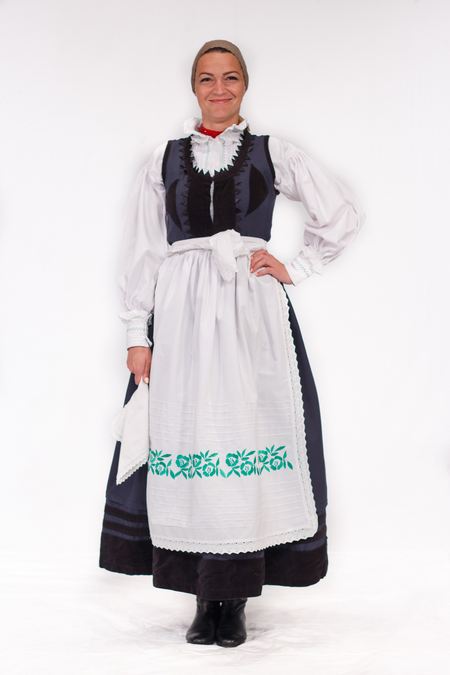
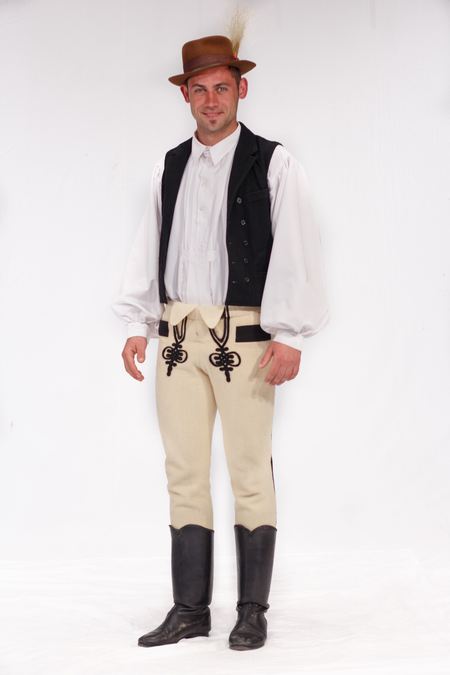

The folk costume from Vajdaszentivány
The essential piece of the men’s costume was the breastplate made of black broadcloth, dressed over the shirt. This was made every time modelled, with a double collar and it was closed with four-five buttons. In length, the vest would cover the upper side of the pants. Here, the ancient version of the pants was also the “harisnya” Sekler traditional pants, made of homemade broadcloth. The everyday pants could be grey, but for celebrations they would wear white. In 1940 these were still worn by every man, a lot of elders also in the 60’s, until they died. Beginning with 1940, the young people have preferred the “priccsesnadrág” type of pants, instead of the traditional pants. The coat was also made of homemade broadcloth. The footwear used on the fields was boots and during summer, shoes or sandals.
|
| |
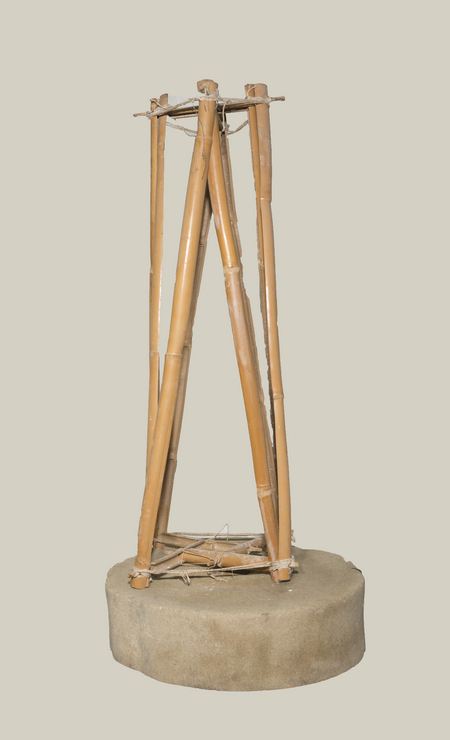
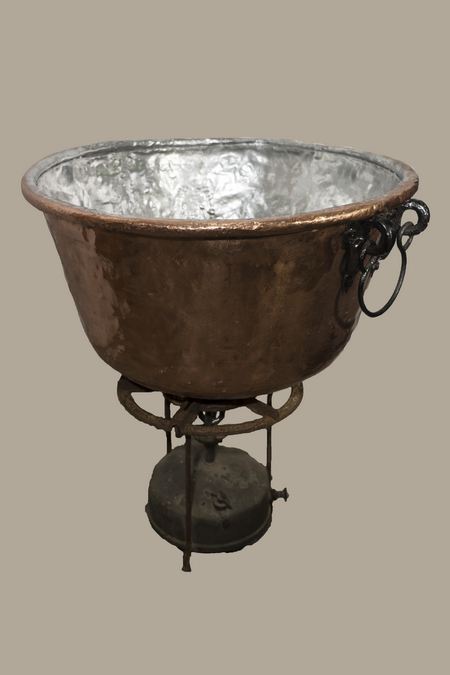
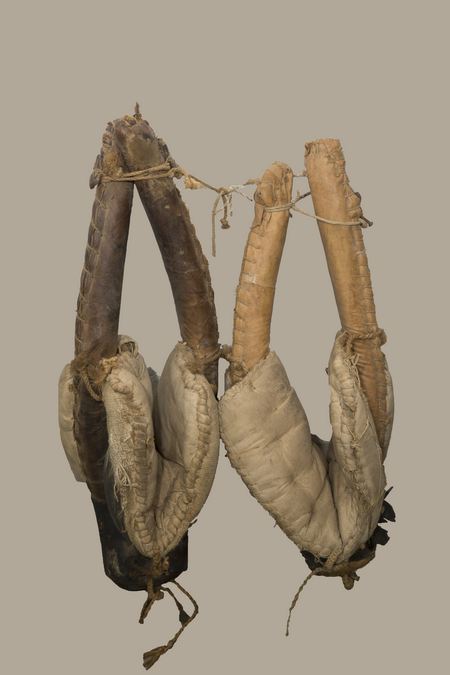
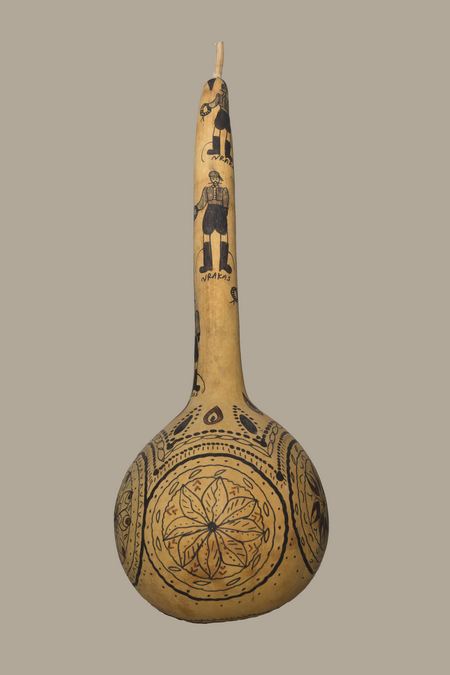
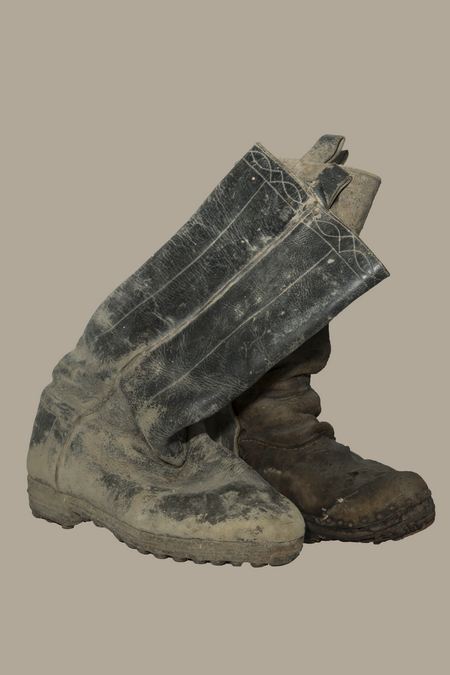


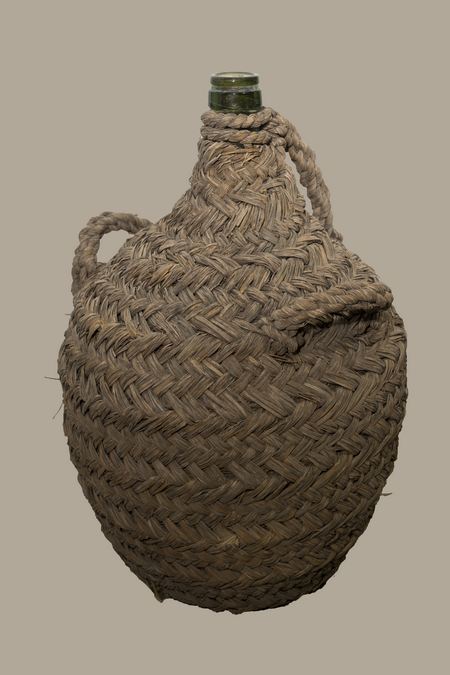
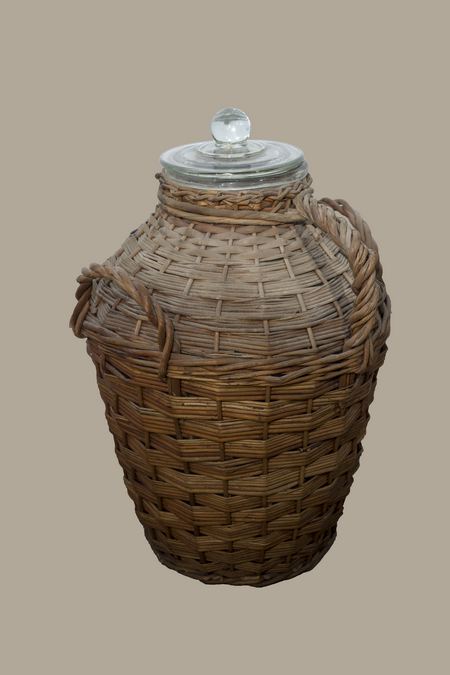
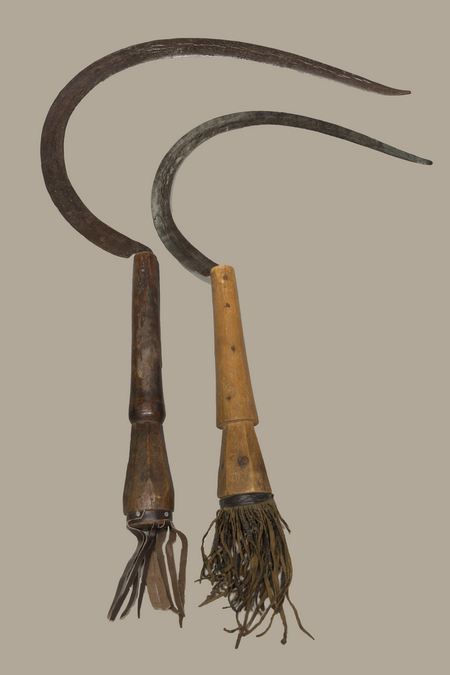
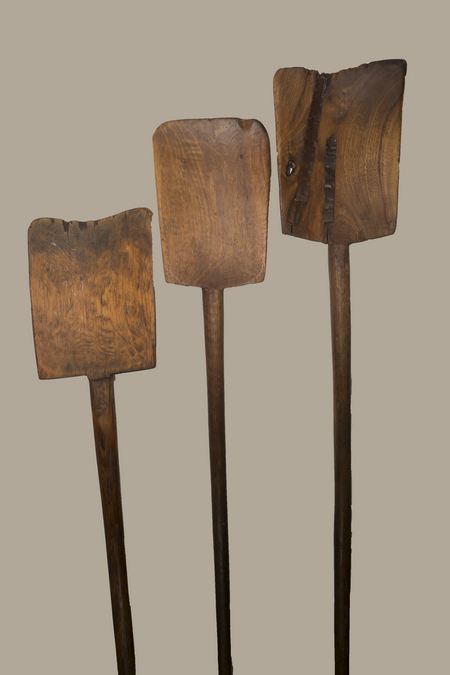
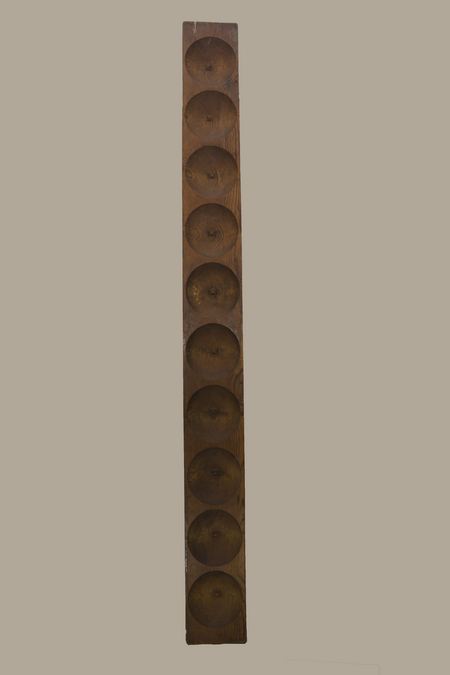
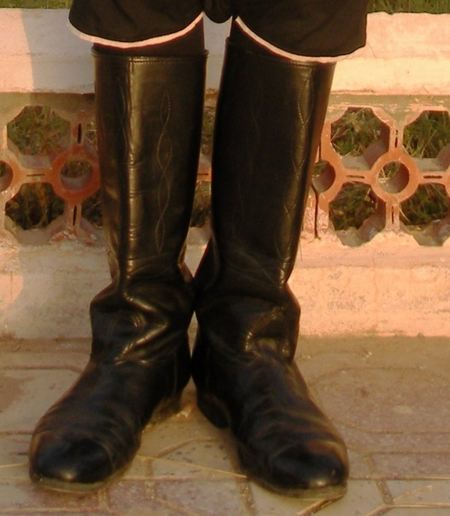
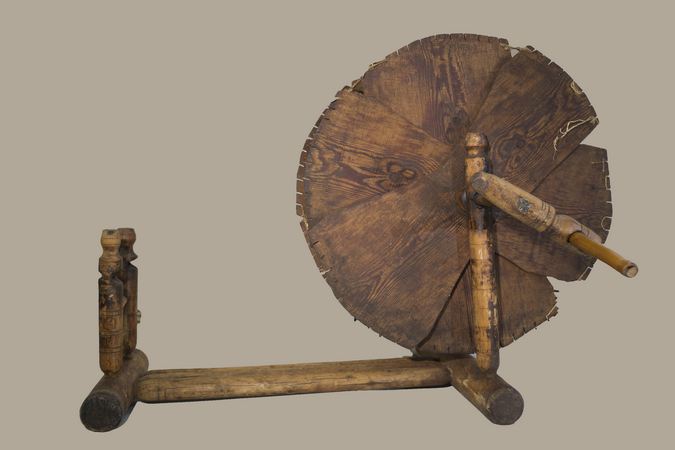
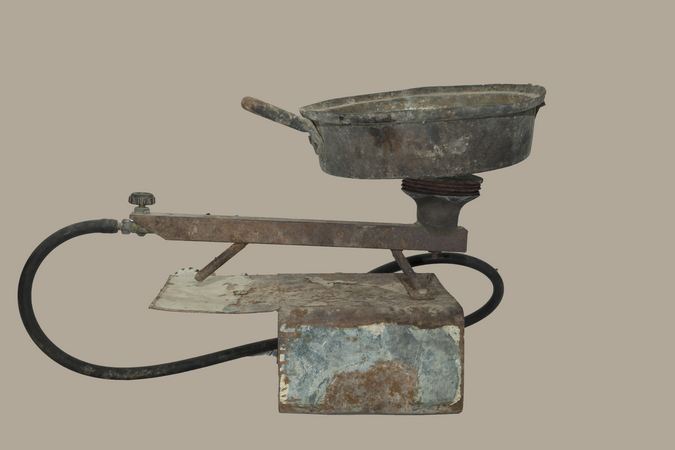
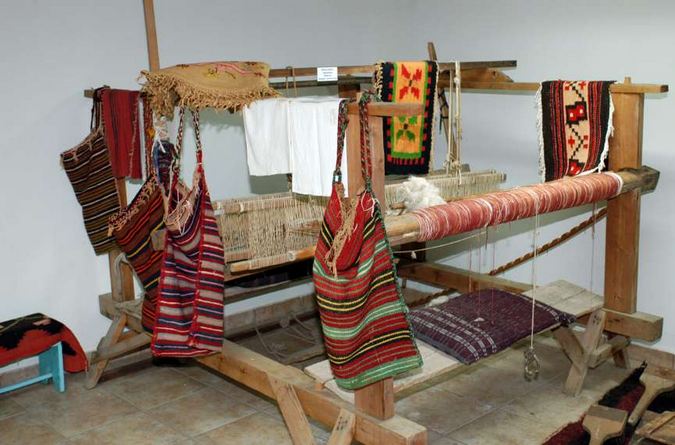
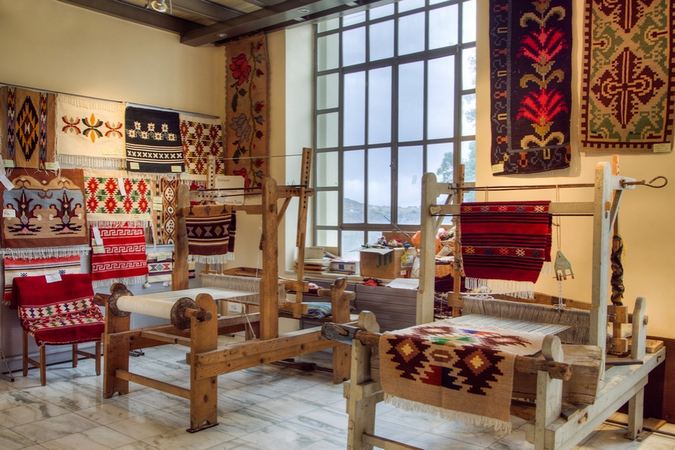
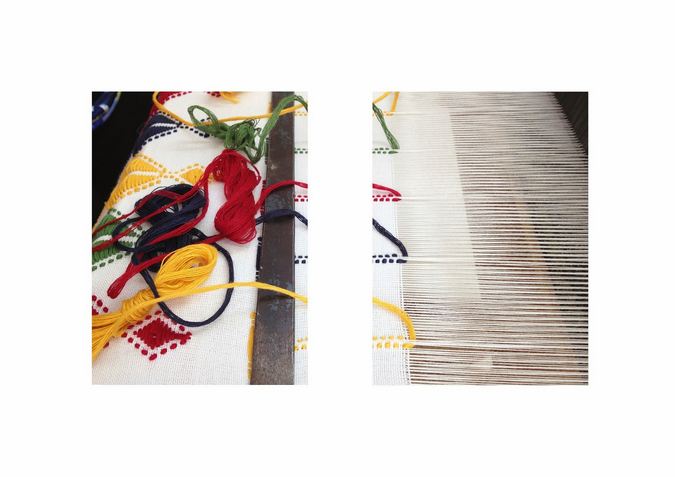
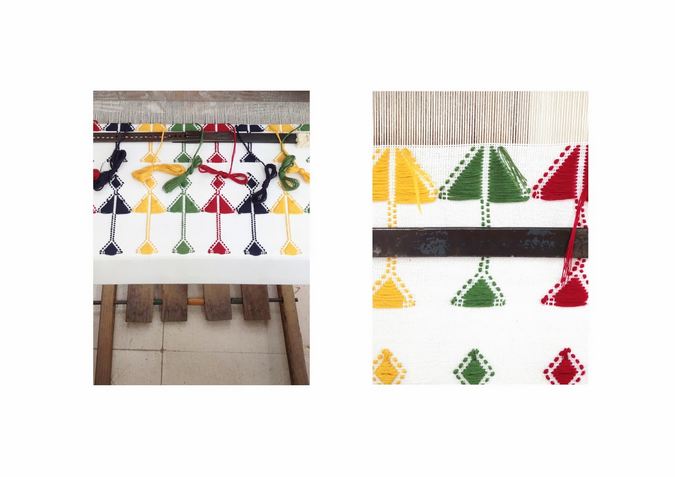
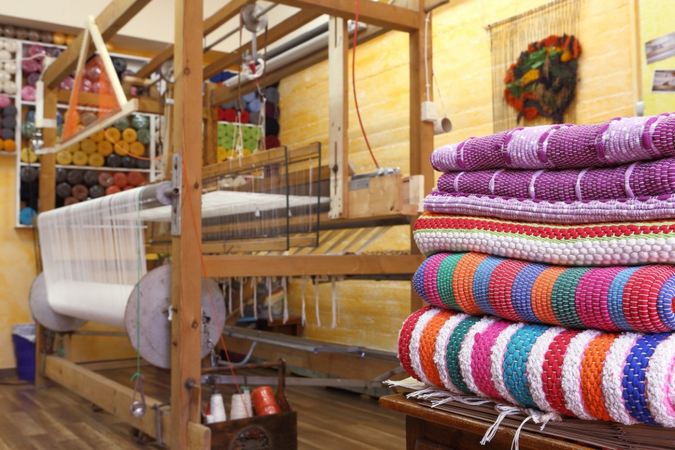
|
|
|